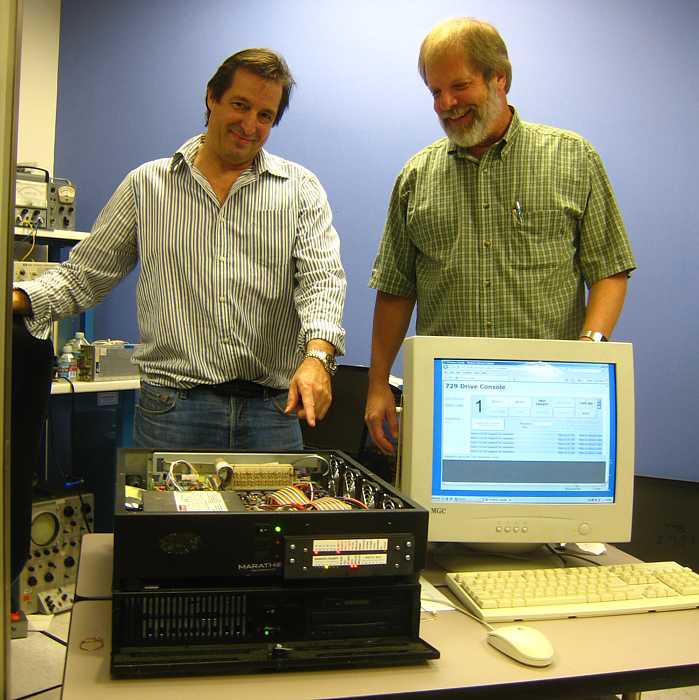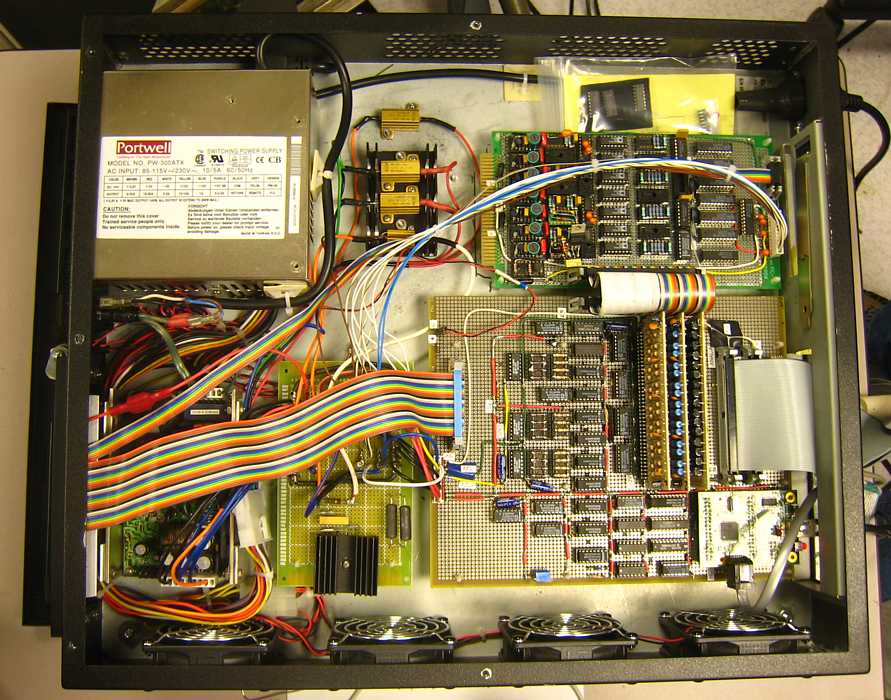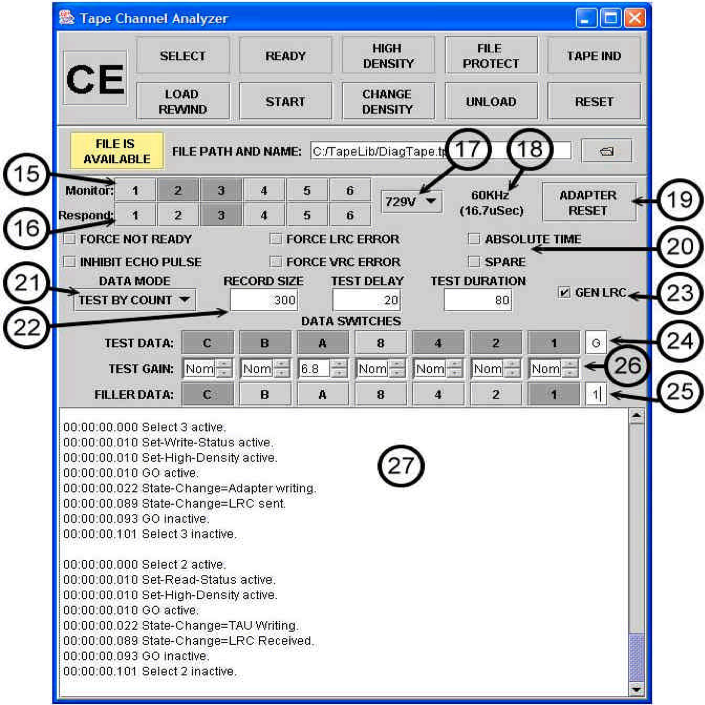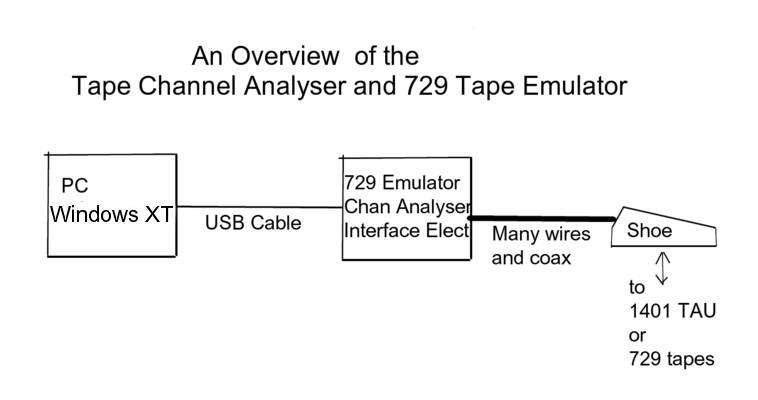Tape Channel Analyser and 729 Tape System Emulator
Bob Feretich, Grant Saviers and Jeff Stutzman worked on this major project
Table of Contents:
- IBM 1401 to PC Interface Adapter proposal by Bob Feretich
- IBM 1401 Tape Channel Analyzer, Spec Ver 1.3 Oct 2008 400 KBytes
- An e-mail from Bob Feretich - 10 Sep 2005
- And a (positive) response from Grant Saviers - 9/10/2005
- Emulator's SVN Repository - Oct 21, 2008 - contains 28 folders, 86 files
- Current Status - Mar 2009 - done, working
- Efforts to upgrade the host PC - as of Dec 29, 2016
- Emulator Documents from Bob Feretich - Jan 2, 2017
- Pictures
- Link to BobFeretich_729Emulator.m4a - 28 MB -
An e-mail from Bob Feretich - 10 Sep 2005
|
Date: Sat, 10 Sep 2005 19:52:52 -0700
From: Bob Feretich
To: 1401 Restoration Team
Staring at step 2, we need to observe and stimulate the 1401's tape drive interface. The complexity of observation and stimulation increases in each step thereafter. Currently, no tape drives are ready to attach to the interface. Even if there was a tape drive that was ready, the ability to observe and stimulate the interface using a standard tape drive is poor. Reasons a real tape drive is a poor choice for early TAU bring-up.
Solution 1 - Build a Lights and Switches Box.
Solution 2 - Build a 1401 Tape Channel to PC interface.
Since we still have not solved the problem of bridging the 1401 Software Development Environment to the 1401 hardware, a "Step 6" could be added to move tape data between the TAU and the PC in a way that fully emulates a tape drive accessing a tape.
Decision needed:
Does anyone object with proceeding with initial implementation of the 1401 Tape Channel to PC interface?
Regards,
|
And a (positive) response from Grant Saviers - 9/10/2005
|
From Grant Saviers, 9/10/2005
To: 1401 Restoration Team
Now that I have assisted Bob with the TAU debug and assisted Allen with the 729 clutch problems, I think building a uP/PC based emulator is a very good idea. With Allen gone for another three weeks, not much is going to happen on the clutch problems (unless somebody else wants to advise me on the internals of the clutch) or can get a 729 operating. Bob's previously sketched out emulator design seems to have enough speed to at least emulate a lower speed 200 bpi drive. I've also studied the TAU analog circuits, and thought about simulating the drive read signals. The capability will also help us debug/test the TAU analog signal paths. I'm signed up to help build Solution 2. I also think a scavenger hunt for a 1401 cable/shoe needs to be done in both 1401 Shoreline and Moffet storage. Grant |
Emulator's SVN Repository
from Bob Feretich, Oct 21, 2008
I have opened the Emulator's SVN repository for anonymous read access.
Updating the repository still requires a valid user ID and password.
The Emulator SVN repositories are located at:
https://svn.rafresearch.com/repos/IBM1401/
(updated May 2014)
You can use your browser to look at the data in the repositories.
You may have to accept my non-standard SSL certificate to access the site.
I access the the Java parts of the project using the Subversive Eclipse
plug-in. For info on the Subversive plug-in see the bottom of this e-mail.
I use TortoiseSVN for checkout/checkin of the non JAVA/Eclipse pieces of
the project. The Drivers are developed under Microsoft Visual C++
Express 2005 (free, there is a 2008 version of it out now, but I have
not upgraded.) The firmware used Microchip's Interactive Development
Environment (IDE). (Also free)
The initial version is tagged "version_1_0".
For the latest version of the data check out the "trunk" copy of the
project that you will be developing. I use the tagged versions for
production releases (frozen versions). 1_2 is the latest production
version. There have been a few minor updates to the trunk since its release.
<
Naming convention for releases:
A release designator consists of |
Current Status - Mar 2009 - done, working
|
TAU Analyzer/729 Emulator The 729 Tape Drive Emulator is operational and stable. We are currently using it to emulate a bank of five 729 drives for our bring-up of the Autocoder (on Tape) software. The Emulator consists of:
Features of the 729 Emulator:
We expect that the Emulator will be an important tool for future educational classes that may be taught using the 1401. Programs that are developed using the PC based 1401 cross-development environment (ROPE) may be loaded and executed directly from the studentsí notebook computers. The Emulator project is now in maintenance mode. No new features are planned. As use of the Emulator increases, bug reports are expected. Reported bugs are being fixed. |
Efforts to upgrade the host PC - as of Dec 29, 2016
1
On 12/27/2016 8:07 AM, Guy Fedorkow wrote:
hi Bob, You probably know that I've been working on a
"Theory of Operation" to help new folks at CHM understand
how the 1401 system works. With considerable help from
Iggy, Carl and others, I've taken a first pass through the
tape subsystem. My draft doc on the tape drive is attached...
It's intended to become a chapter in the overall doc, which is
posted on Ed's web page under the name
"modern theory of operation".
But I wonder if you might have time and interest to
take a look through the draft and see if I've misunderstood
any of the details of the machine? There are quite a few
spots marked in orange text where I have questions or uncertainty...
many of those I know how to resolve with a bit more research,
but I'd be glad to have comments on any part of the doc.
It also struck me that I should add a paragraph or two
on the TAU emulator, as it's an important part of CHM's
restoration effort, even if it wasn't part of the original machine.
But I think I've seen docs on this on Ed's eclectic web site;
I'll look that up. Let me know if you see anything in the doc
you'd want to correct?
Thanks for your help!
/guy fedorkow
apparently attached to the original e-mail
< IBM-1401-Theory-of-Operation-Tape-tmp1.docx >
--------------------------------------
2
From: Bob Feretich
Date: December 29, 2016 at 12:53:18 AM PST
To: Guy Fedorkow
Cc: ...
Subject: Re: IBM 1401 tape drive description - with attachment
My comments on your draft are in the document using a green font.
Overall it looks very good.
You should probably write a little about the "Rewind", "Rewind & Unload",
and "Tape Indicator" logic. All of these are implemented in the TAU/729
by combinational (unclocked) logic. The failure of one of the handshake
signals results in everything being hung.
There is no indication if it was the CPU, TAU, or 729 that failed.
The Emulator manual (cited below) has a pretty good description of each
of the 729/TAU interface signals as well as a discussion of the "Rewind"
and "Rewind & Unload" operations.
Tape Indicator seems to be a giant set/reset flip-flop that has its
feedback paths span the TAU and the 729; and has some subtle side effects
on TAU operation. I troubleshot a problem in this logic before.
The failure of one of the signals in the feedback loop caused the
TAU/drive to hang and requires the troubleshooter (me) to dig through pages
and pages of TAU and 729 ALDS to identify the entire feedback circuit.
Unfortunately, I don't recall the implementation. This is an area
where I am not sure that I got the Emulator implementation correct.
The 729 Emulator specification are on the web at...
IBM 1401 Tape Channel Analyzer, Spec Ver 1.3
It was named the Tape Channel Analyzer because it goes beyond just
emulating the 729 tape drives and for some political reasons that existed
in the early days.
It contains some support to emulate various 729 failures that can
exercise recovery logic in the TAU.
It is able to emulate one drive up to an entire bank of tape drives.
(Possible because the TAU only enters a session with one drive at a time
and that it has an entire IRG delay to switch from one drive to the next.)
It can also mimic the timings of any type of 729 drive.
Regards,
Bob
-----------------------------------
3
On 12/21/2016 9:48 PM, Marc Verdiell wrote:
Bob,
Got the servlet working on the new machine - once I understood that
the only thing I needed was to deploy the .war file
it got a lot easier ;-)
Now I am struggling with the USB driver install.
I found the generic.sys, tapeusb.sys and tapeusb.inf in one folder.
I thought I just needed to point the new hardware found wizard
to the .inf file in that folder, but it hangs the wizard
(stays forever trying to install it).
Anything I missed? Any other way to install it
(I tried right clicking the .inf and choosing install,
but that did not work either)? I have not tried force installing yet.
Also, what do I do with tapesubdll.dll file
which I found in a different folder?
Thanks,
Marc
---------------------------------------
4
From: Bob Feretich
Date: Wednesday, December 21, 2016 at 11:02 PM
To: "marc.verdiell@gmail.com"
Cc: ...
Subject: Re: Tape emulator help
Good progress.
What are the characteristics of the new machine?
Is it running Windows XP? Anything newer would be a problem. The driver
model changed after XP.
Are the drivers in the same folders where they were originally installed?
The .inf file guides windows through the driver installation. Based upon
the OS level, it conditionally copied driver software from the source
location to the final install location.
There is help info on the web regarding how to interpret the .inf
contents. Most of the source / destination path name segments are pulled
from environment variables.
Assuming you are running XP, the environment variable values would be
the first thing I check.
Regards,
Bob
------------------------
5
On Dec 29, 2016, at 1:54 AM, Bob Feretich wrote:
My holiday guests have just departed, so I am starting go work down
the backlog of work that came up.
Sorry that there was a delay.
My comments are inline... [ colored red on this web page ]
On 12/22/2016 10:07 PM, Marc Verdiell wrote:
Bob,
Itís a HP small form factor WinXP SP3 machine, much more recent
than the current one, multi Gb/s processor, 2G of RAM, relatively
large disk, clean install, everything works,
should run the emulator easily.
The machine seems to be compatible.
I believe the problem is exactly what you say, as I am trying to
fish the relevant files from the old installation. Do you happen
to have a clean distribution of the driver with the folders already
at the right place?
From my examination of the tapeusb.inf file...
|
Emulator Documents from Bob Feretich - Jan 2, 2017

Stutzman & Feretich |

Top View Interface Electronics |

Front View Electronics Box |

Sam Sjogren at console |

User Interface (PC) |

User Interface (PC) |
